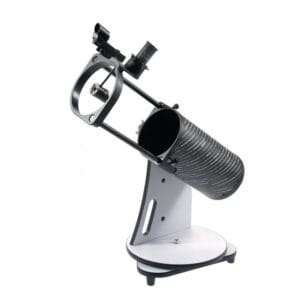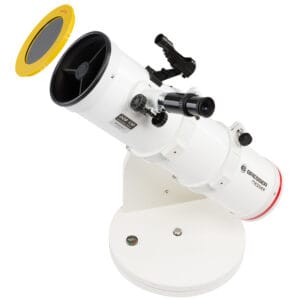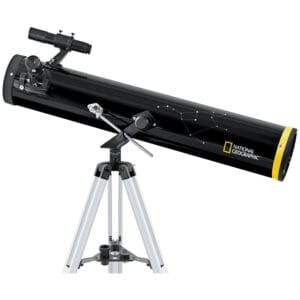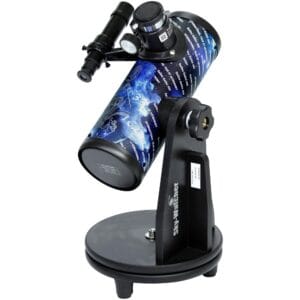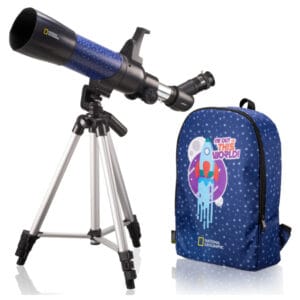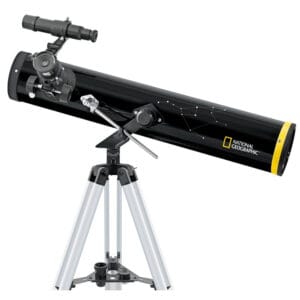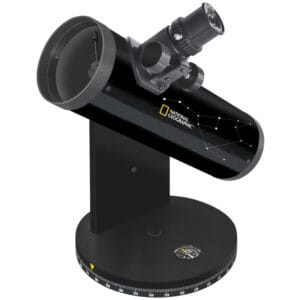For children

Showing all 13 resultsSorted by popularity
Showing all 13 resultsSorted by popularity
Telescopes for kids - Read our recommendations
Our three recommended children's telescopes
To make it easy to choose, we have listed directly at the top the three models that work best in practice for children. They are robust, easy to use and really show something.
National Geographic 76/700 Reflector
This scope is ideal for children ages eight and up. The 76 mm mirror captures enough light to show the moon, Jupiter, Saturn and the brightest nebulae recognizably. The 700 mm focal length allows children to focus easily and keeps objects more quietly in focus. The set comes complete with two eyepieces, viewfinder and tripod, so you can get started right away.
National Geographic Dobson 114/500
This is a compact table-top Dobson that children can operate intuitively. You turn it by hand in the right direction without buttons or complicated movements. The 114 mm aperture produces remarkably bright images, revealing star clusters such as the Pleiades and the Orion Nebula. For kids who like to look for themselves, this is one of the finest beginner models.
Celestron StarSense Explorer LT 70 AZ
For families who prefer to be guided by an app, this is the best choice. StarSense technology helps kids find planets and stars on their own by simply clicking their phones into the mount. The 70 mm refractor shows the moon, Jupiter and Saturn well, and thanks to the tripod, everything is stable. Also fun: kids can take their first pictures with their smartphones.
The first time a child looks through a telescope
Something extraordinary happens when a child sees the moon sharply for the first time. The white dot turns into a landscape full of craters. Jupiter turns out to have four moons that shift, Saturn has rings, and stars are suddenly distant suns. That first moment determines whether a child becomes curious or disengaged.
Therefore, at Telescoop.co.uk we only choose models that give children real results. Not toys, but entry-level models that are easy to operate and allow young explorers to explore the sky without frustration.
What makes a telescope suitable for children?
A good children's telescope is not about technical terms, but about ease of use. A child should be able to aim it himself, without every push causing vibration. Refractors give instant images without adjustment; Dobsons are nice precisely because you move the tube by hand.
More important than the specifications is the experience:
a child should see something within a few minutes that excites them. The moon in detail, Saturn as a miniature world with rings, or a star cluster that suddenly appears to consist of dozens of points of light.
Optical quality plays a big role in this. The difference between a “toy scope” and a real beginner's scope is that with the latter you do get sharp images. That determines whether the amazement grows or disappears.
Dobson or tripod - which works best for children?
Dobson
A Dobson stands directly on the table or on the ground and moves smoothly with your hand. For children, this feels natural: you just push the telescope in the direction you want to look.
Advantages:
children have quick moments of success
ideal for the moon, Jupiter, Saturn and star clusters
operates without complicated buttons or mechanics
Disadvantage: you need a stable, low table or bench to watch on.
Tripod
A tripod feels familiar to parents and works well in the garden or on the balcony.
Advantages:
stable on any surface
ideal for telescopes with app assistance such as the StarSense models
useful for taking smartphone photos
Disadvantage: young children must learn that a tripod vibrates when you push against it.
Simply put:
Do you want a child to search and aim independently? Then a Dobson is a better fit.
Do you want help from an app and watch together? Then a tripod telescope makes more sense.
What children can see
Even with a simple telescope, the sky turns into something tangible. The moon shows sharp craters and long shadows along the terminator (the border area between light and dark). Jupiter appears with its four large moons, changing position night after night. Saturn shows its rings - the most magical moment for many children.
Under dark skies, star clusters can also be seen, such as the Pleiades. With some patience, you can find the Orion Nebula, a cloud of gas in which new stars are forming. These are observations that leave a deep impression, precisely because children see them live through the telescope and not on a screen.
Which telescope suits which age?
There is no set age to start. Experience shows:
6-7 years: looking together, refractor on tripod is easiest
8-10 years: children can aim themselves, especially with a table-top Dobson
10+ years: Children can search, focus and track longer objects independently
Refractors are hassle-free to use and instantly ready; Dobsons are ideal for kids who like to do everything themselves. Smart telescopes with app help give quick results and are perfect for families who want to get started without technical knowledge.
How children learn to watch
Stargazing teaches children more than just about space. They learn patience, concentration and pattern recognition. The moment they focus on a planet is often unforgettable. Start small: first the moon, then Jupiter or Saturn. Once the basics are in place, the rest will follow naturally.
Our guidance and service
Choosing a telescope for a child is something you do together. We are happy to help you choose the right model via WhatsApp or email and tell you honestly what to expect with it. Everything is checked upon shipment, so you can get started right away.
Ordered today = delivered within 48 hours, ready to use.

